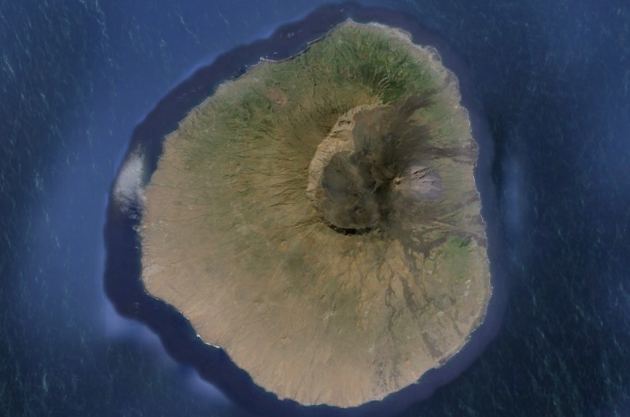The Most Destructive Wave in Earth's (Known) History
Geologists have discovered evidence of an ancient 560-foot mega-tsunami.
- Adrienne LaFrance
- 10.23.2015
Rising from the Atlantic ocean, hundreds of miles off the coast of West Africa, there's a volcano with a 73,000-year-old scar swiped across its face. This is the mark of an ancient catastrophe, etched into the rock when a huge chunk of the volcano's eastern flank rushed all at once into the sea.
That particular flank collapse displaced enough water to generate a powerful tsunami—one that, new evidence shows, might have been much, much bigger than geologists previously believed. "Our work provides evidence that the well-known collapse at Fogo volcano produced a very large tsunami that impacted the nearby island of Santiago," said Ricardo Ramalho, an Earth-sciences research fellow at the University of Bristol.
"Very large," even by tsunami standards, seems like an understatement here.
Ramalho and his colleagues identified giant boulders almost half a mile inland, hundreds of feet above sea level, that they believe were transported by a mega-tsunami. Based on what they found, the scientists believe the tsunami swelled to a height of about 560 feet, tall as the Washington Monument, before inundating the island. "These characteristics make this event one of the largest mega-tsunamis preserved in the geological record," Ramalho and his colleagues wrote in a paper about their findings.
 Satellite imagery shows the scar from Fogo's huge flank collapse 73,000 years ago. (Google Earth)
Satellite imagery shows the scar from Fogo's huge flank collapse 73,000 years ago. (Google Earth)Flank collapses like the one that decimated what is now Santiago are rare, but not unheard of. Hawaii has its own history of mega-tsunamis, most recently about 100,000 years ago. "One block of rock that slid off Oahu is the size of Manhattan," wrote Becky Oskin in Live Science.
"Underwater images of the seabed surrounding the Hawaiian Islands show that they are surrounded by huge aprons of debris shed from their volcanoes over tens of millions of years," the writer Bill McGuire wrote in his book, A Guide to the End of the World. "Within this great jumbled mass of volcanic cast-offs, nearly 70 individual giant landslides have been identified."
In at least one such landslide, a 1,000-foot mega-tsunami slammed into the island of Lanai. A wave that big on Oahu today would almost certainly wipe out Honolulu. But scientists can't say for sure how—or, critically, when—such a catastrophe would play out. That's largely because no one in recorded history has seen one of these things. "The lack of direct observations means that little is still known on the mechanics of collapse development," Ramalho and his colleagues wrote in their paper.
Most tsunamis are generated from tectonic activity. For instance, huge earthquakes triggered the two most destructive tsunamis in recent history: the 2011 Japan tsunami and the 2004 Indian Ocean tsunami. In both cases, record wave height topped out between around 100 feet and 130 feet.
Now imagine a tsunami five or even 10 times that size.
Most scientists agree that a catastrophic flank collapse will generate an unimaginably massive tsunami again someday, but they're cautious about guessing when it might happen. A popular ballpark estimate: maybe sometime within the next 100,000 years. Whatever the case, a volcanic-flank collapse in Hawaii would generate a series of giant tsunamis that would likely destroy cities in several countries, including in the United States, Canada, Japan, and China, McGuire says. "In deep water, tsunamis travel with velocities comparable to a jumbo jet," he wrote, "so barely 12 hours will elapse before the towering waves crash with the force of countless atomic bombs onto the coastlines of North America and eastern Asia."
The hazard of these "very low-frequency, very high-impact" geologic events should not be underestimated, Ramalho told me, but the potential for such catastrophes shouldn't cause panic either. "We better improve our resilience to their impacts," he said. "We should improve our monitoring capabilities of possible volcanic sources, we should do more research on the subject, and we should—rationally and cooly—think of what can be done to mitigate the possible impacts of such an event."
--
__._,_.___
No comments:
Post a Comment